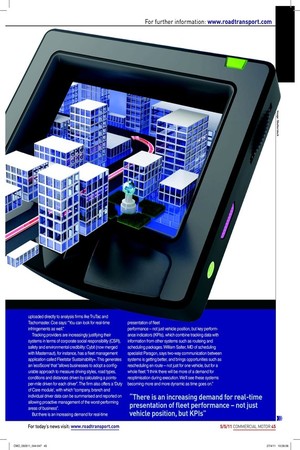REPORTING AND ANALYSIS
Page 39

Page 40

If you've noticed an error in this article please click here to report it so we can fix it.
The obvious development from tracking is to look at historical trip data, to see if vehicles have deviated from their routes – “plan vs actual” reporting. This is straightforward enough, and most tracking systems have a variety of reports built in.
Microlise offers a ‘Business Intelligence Module’ that uses the Microsoft SharePoint structure to distribute reports around an organisation. These can include KPIs such as: asset utilisation, planned vs actual-total trips, time and distance, cube, pallet and weight, trips per driver and tractor, distance per trip, cost per trip, cost per km or per case, unscheduled stops and backhaul turnaround. Tracking systems are still seen as a way of monitoring and controlling driver behaviour. Many systems include Working Time Directive compliance, and links to a vehicle’s digital tachographs; rather than download the driver card information manually, it can be uploaded directly to analysis firms like TruTac and Tachomaster. Coe says: “You can look for real-time infringements as well.” Tracking providers are increasingly justifying their systems in terms of corporate social responsibility (CSR), safety and environmental credibility: Cybit (now merged with Masternaut), for instance, has a fleet management application called Fleetstar Sustainability+. This generates an ‘ecoScore’ that “allows businesses to adopt a configurable approach to measure driving styles, road types, conditions and distances driven by calculating a pointsper-mile driven for each driver”. The firm also offers a ‘Duty of Care module’, with which “company, branch and individual driver data can be summarised and reported on allowing proactive management of the worst-performing areas of business”.
But there is an increasing demand for real-time presentation of fleet performance – not just vehicle position, but key performance indicators (KPIs), which combine tracking data with information from other systems such as routeing and scheduling packages. William Salter, MD of scheduling specialist Paragon, says two-way communication between systems is getting better, and brings opportunities such as rescheduling en route – not just for one vehicle, but for a whole fleet: “I think there will be more of a demand for reoptimisation during execution. We’ll see these systems becoming more and more dynamic as time goes on.”
















































